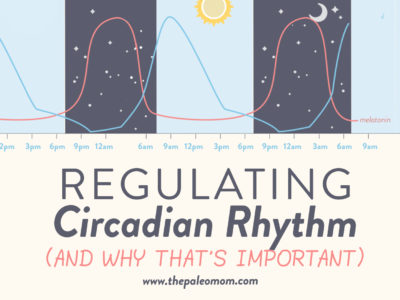 Happy New Year! For me, like many, the start of a new year is a time of reflection. I look back over the last year, appreciate my accomplishments and the challenges I overcame, note where I fell short of my goals, and think forward to the year ahead with optimism, determination and resolve. The unique challenges of 2020 and 2021, though, make this new year especially poignant.
Happy New Year! For me, like many, the start of a new year is a time of reflection. I look back over the last year, appreciate my accomplishments and the challenges I overcame, note where I fell short of my goals, and think forward to the year ahead with optimism, determination and resolve. The unique challenges of 2020 and 2021, though, make this new year especially poignant.
As we all collectively say good riddance to 2021, we’re also preparing to be inundated even more than usual with body-shaming, emotionally manipulative marketing for weight-loss programs, detoxes, and supplements to help us loose the “quarantine fifteen”. Before you invest in weight loss-centered New Year’s resolutions, I want to point you to my in-depth article Can You Really Be Healthy at Any Size? that discuss the value (or rather complete lack thereof) of this type of goal. Okay, now that we’re on the same page about weight loss versus health, let’s talk about the real challenge holding us back from achieving our goals: habit!
Why Focus on Habits for New Year’s Resolutions?
About 40% of the day-to-day actions we take aren’t goal-directed behaviors (i.e., conscious decisions), but rather are behaviors driven by stimulus-response associations that are performed automatically requiring no conscious thought, i.e., habits. And, when a goal conflicts with a habit—for example, a weight loss goal conflicting with a habit of eating junk food in front of the TV in the evening—that’s where achieving the goal requires that dreaded word… willpower. It takes a huge amount of effort to not do something that we normally do completely unconsciously in response to a stimulus as simple as our environment. And, as soon as we aren’t paying attention, we revert to our habitual behavior, undermining our progress towards our goal without even thinking about it! This is why a close look at the habits that are interfering with our goals is such a critical aspect of New Year’s resolution success (and success at adopting healthy changes to diet or lifestyle any time of the year).
 In fact, studies have shown that people who are score highly in measures of self-control don’t actually achieve their goals because of exerting that self-control. Rather, these people are highly effective at forming good habits that contribute to successful outcomes!
In fact, studies have shown that people who are score highly in measures of self-control don’t actually achieve their goals because of exerting that self-control. Rather, these people are highly effective at forming good habits that contribute to successful outcomes!
Save 80% Off the Foundations of Health
Expand your health knowledge on a wide range of topics relevant to you, from how to evaluate scientific studies, to therapeutic diet and lifestyle, to leaky gut and gut microbiome health, to sustainable weight loss, and much more!!!

When I make New Year’s resolutions, they are always habit centered. For example, if my ultimate goal is to lose weight, I make resolutions that focus on habits that contribute to weight loss and better health in general. The resolution isn’t to lose 15 pounds, but instead I resolve to: quit snacking; eat a high-protein breakfast every day (like soup); go to bed an hour earlier; and lift weights and work at my treadmill desk more often. These resolutions (which should all contribute to achieving and maintaining a healthy body composition, see Healthy Weight Loss) mean the health benefits don’t cease when I hit my goal, and because there’s no timeline involved, I’m less likely to lose my momentum if I don’t reach that goal quickly.
So, to help inure all of us to predatory marketing this new year, let’s dive into the science behind habit formation and center our resolution priorities on healthy habits that can last a lifetime.
 The Science of Habit Formation
The Science of Habit Formation
Scientifically, habits are defined as a routine behavior that is performed automatically and unconsciously in response to a stimulus, and that is insensitive to devaluation of reward and contingency degradation. What does that mean? Habitual behaviors are performed the same way every time we encounter its stimulus, even if the perceived benefit we derive from the behavior decreases over time, and even if we can no longer distinguish a cause and effect of our behavior. If you’re a wee bit weirded out by the idea of 40% of your daily actions being performed without conscious thought or intention and without even a bona fide link to an expected outcome or benefit, it’s helpful to know that there are huge advantages to habits.
Habits are a form of learning and start out as a goal-directed behavior, reinforced by reward, and performed routinely in the same context every time. At the beginning of this learning, multiple parts of the brain are being used to perform the behavior, most notably the striatum in the basal ganglia and the prefrontal cortex. (The basal ganglia is the region of the brain associated with emotion, memories, pattern recognition, procedural learning and control of voluntary motor movements. The prefrontal cortex is the region of the brain associated with executive function and cognitive control , including attentional control, cognitive inhibition, inhibitory control, working memory, cognitive flexibility, information processing, planning, reasoning, problem-solving, organization, and decision making.) As the behavior is repeated and mastered, the prefrontal cortex is used less and less to perform the behavior while the basal ganglia takes over. Eventually, the prefrontal cortex isn’t used at all to perform the habitual behavior, freeing up valuable executive function for other tasks.
This is why you can hold a conversation while you drive or cook dinner. The actions you’re performing have become a habit so your prefrontal cortex can do other things at the same time. This is also why the behavior becomes dissociated from the reward or even expected outcomes—the part of the brain that processes action and effect, and much of the sophisticated reward circuitry in the brain, is no longer involved! The context the routine started in becomes the habit stimulus, and the behavior can now be performed automatically in response to the stimulus, without the need for conscious thought! It’s actually quite an amazing learning system! The habit learning system increases efficiency, saving valuable mental energy, but comes at the expense of flexibility.
Aside: There’s an interesting role for the endocannabinoid system in habit formation, with CB1 receptors mediating the switch from goal-directed behavior to habit, see CBD: Panacea, Snake Oil, or Somewhere in between?, Podcast Episode 393: CBD, and Podcast Episode 420: CBD for Pain Management. There are some interesting studies showing that CBD can reduce some habitual behaviors, like binge eating or drinking, but reinforce habit learning in animal models. The jury is still out on whether CBD could help with habit-centered resolutions!
When it comes to habit-centered resolutions, this may mean both forming new good habits as well as breaking old bad habits. Let’s go into detail in terms of how habit learning versus unlearning are different in practice.
How to Form a Good Habit
If you’re forming a good habit, you are learning to do something in response to a stimulus, i.e., there’s an action that you are working on repeating routinely in a stable context until it’s automatic. This new beneficial action may replace a detrimental action you used to perform in response to the same stimulus (e.g., drinking water instead of soda with lunch—lunchtime is the stimulus, drinking soda is the old bad habit and drinking water is the new good habit), but it’s still considered habit formation with the new habit dislodging the old habit from the basal ganglia.
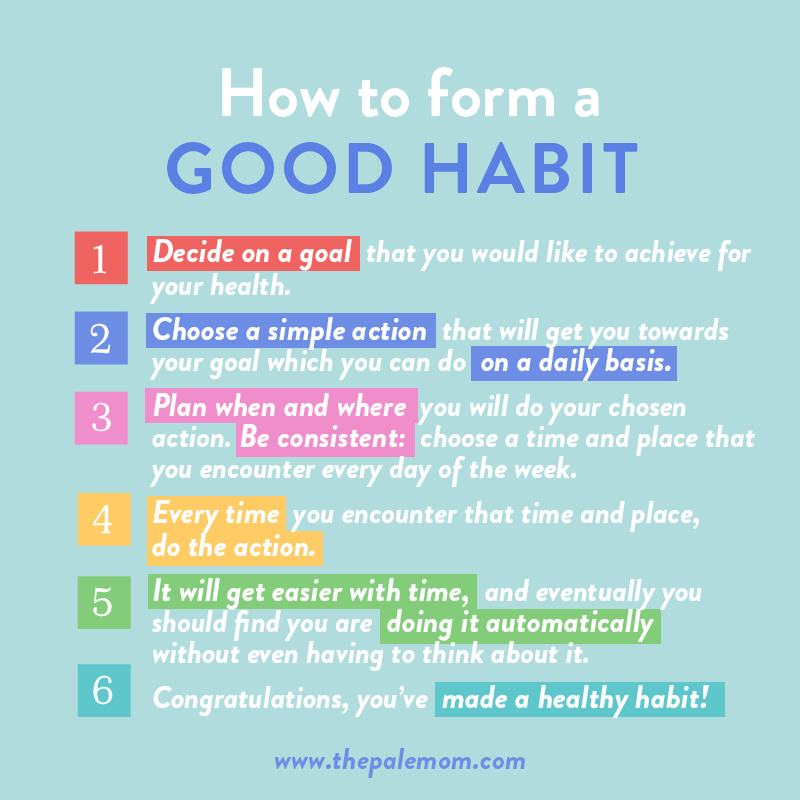 How do you form a habit? The following protocol comes from a scientific paper offering guidance to physicians to help improve their patient’s health by focusing on habit formation.
How do you form a habit? The following protocol comes from a scientific paper offering guidance to physicians to help improve their patient’s health by focusing on habit formation.
- Decide on a goal that you would like to achieve for your health.
- Choose a simple action that will get you towards your goal which you can do on a daily basis.
- Plan when and where you will do your chosen action. Be consistent: choose a time and place that you encounter every day of the week.
- Every time you encounter that time and place, do the action.
- It will get easier with time, and eventually you should find you are doing it automatically without even having to think about it.
- Congratulations, you’ve made a healthy habit!
How long is eventually in this context? Unfortunately, it’s a myth that it takes 21 days to make or break a habit. For the vast majority of us, it takes dedication and commitment to repetitively perform a task for a much greater length of time before that task becomes automatic.
In fact, research shows that the average length of time it takes to form a new habit is 66 days, but that the time required for form a habit varies from 18 days to 254 days (about 8 months)!!!! This likely varies from person to person, but also by type of habit and the individual challenges each of us face to making a specific change. Chances are good that if it’s a habit you’ve unsuccessfully tried to create before, it’s going to take a longer amount of time to get it right this time.
Fortunately, there are some things that you can do to support habit formation and potentially speed up the time investment.
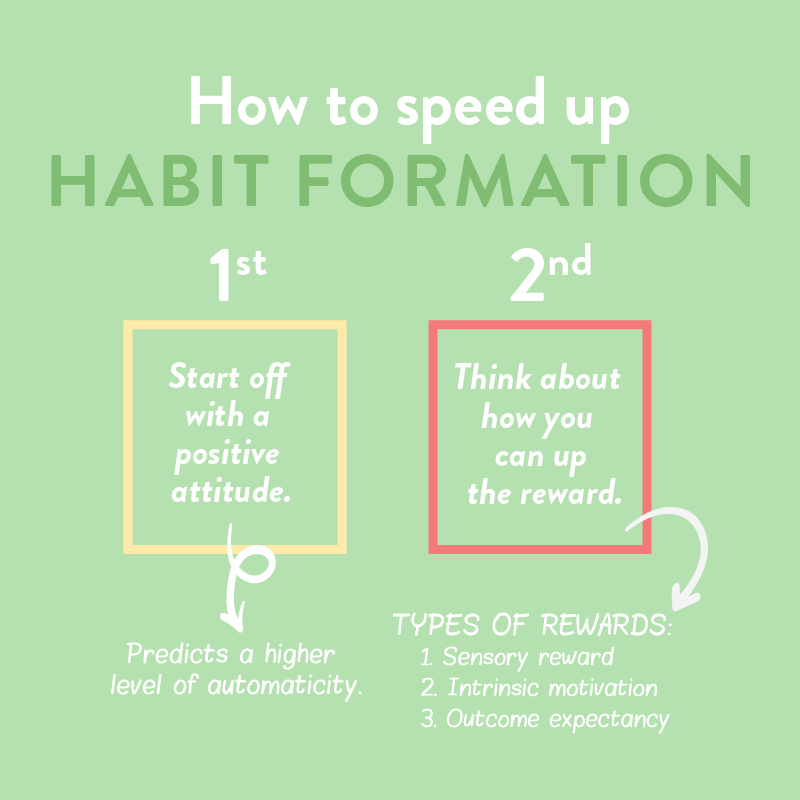 First, start off with a positive attitude.
First, start off with a positive attitude.
A study evaluating the psychological determinants of habit formation (using daily flossing as the habit being formed) revealed that starting out with a positive attitude about the new behavior being performed predicted a higher level of automaticity after four weeks and habit maintenance at 8 months. (Other determinants that positively impacted habit formation were stronger prospective memory ability and higher levels of past behavior.) In this study, participants were motivated with persuasive information about the benefits of flossing and instructed to floss daily. A questionnaire measured attitude by asking strongly agree to strongly disagree with statements related to the information. Basically, the more the person understood the benefits of flossing, the more likely they were to form a strong flossing habit! Ah, knowledge is power!
You can apply the insights from this study by taking some time to learn why a certain habit will help you reach your goal. This is why I’ve worked so hard to create top-quality detailed educational resources like my collection of online courses. My students report high levels of success in adopting and sticking with diet and lifestyle changes to support their health journeys. My Foundations of Health online course is a great place to start if you have health-focused goals for 2021 like wanting to eat better or lose weight in a healthy way, and my AIP Lecture Series intensive online course is perfect if you need to dig deeper into the links between diet and lifestyle and chronic illness!
Second, think about how you can up the reward.
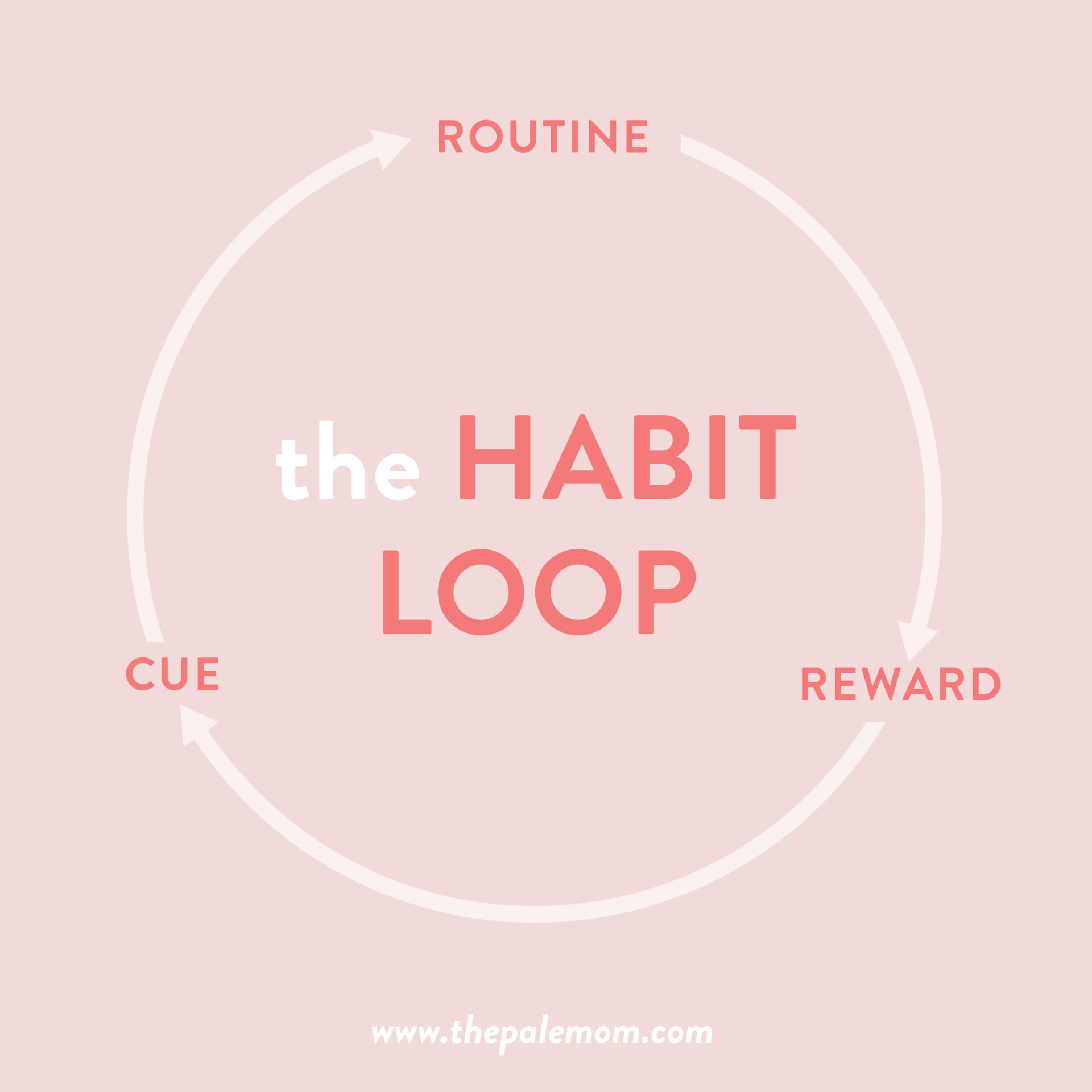 Once a habit is formed, the behavior becomes dissociated from reward; but in the learning phase, boy oh boy, does reward make an impact! A simple neurological loop, called the habit loop, is at the core of every habit. The habit loop consists of a stimulus or cue, an action performed in response to the stimulus, and a reward that reinforces the loop. Studies show that increasing the perceived reward strengthens habits beyond the impact of repetition, meaning that it takes fewer repetitions for a rewarded behavior to become a habit compared to an unrewarded behavior.
Once a habit is formed, the behavior becomes dissociated from reward; but in the learning phase, boy oh boy, does reward make an impact! A simple neurological loop, called the habit loop, is at the core of every habit. The habit loop consists of a stimulus or cue, an action performed in response to the stimulus, and a reward that reinforces the loop. Studies show that increasing the perceived reward strengthens habits beyond the impact of repetition, meaning that it takes fewer repetitions for a rewarded behavior to become a habit compared to an unrewarded behavior.
There are different types of rewards. An obvious one is pleasure, defined as positive and immediate sensory outcome, why delicious foods or intoxicating substances can be habit-forming. Another form of reward is intrinsic motivation, wanting to perform an action because of anticipated inherent enjoyment of doing so. Intrinsic motivation is a more powerful reward than extrinsic motivation (being motivated to do an action to please others). Another form of reward is positive outcome expectancy, understanding a good effect will result from the action—another way that learning can help support good habit formation.
You can apply the insights from these studies by thinking of ways to up the reward ante when you perform your repetitive task. This doesn’t mean eating a chocolate bar right after working out as a reward, but rather thinking about the inherent reward from a task and finding a mindset where the task itself is associated with a positive experience or anticipated outcome. This is where gamification can be super handy! For example, if your goal is to make walking 10,000 steps a day your habit, a fitness tracker that rewards you with a push notification congratulating you when you reach your daily step count can be very helpful! Also, it’s okay if the reward is delayed (some studies show it might even be better to be delayed!) as long as it’s clearly associated with the behavior.
It’s also helpful to avoid negative outcome expectancy. Studies have shown that associating a negative experience with a task devalues the reward. Remember, this isn’t an issue after a habit is formed, but it can stop habit formation right in its tracks! So for example, if you’re looking to create a new habit of working out in the mornings, it’s helpful to reign in the intensity to a level where exercising is enjoyable. Going so hard at the gym that you throw up isn’t going to help you form an exercise habit (or muscles for that matter).
How to Break a Bad Habit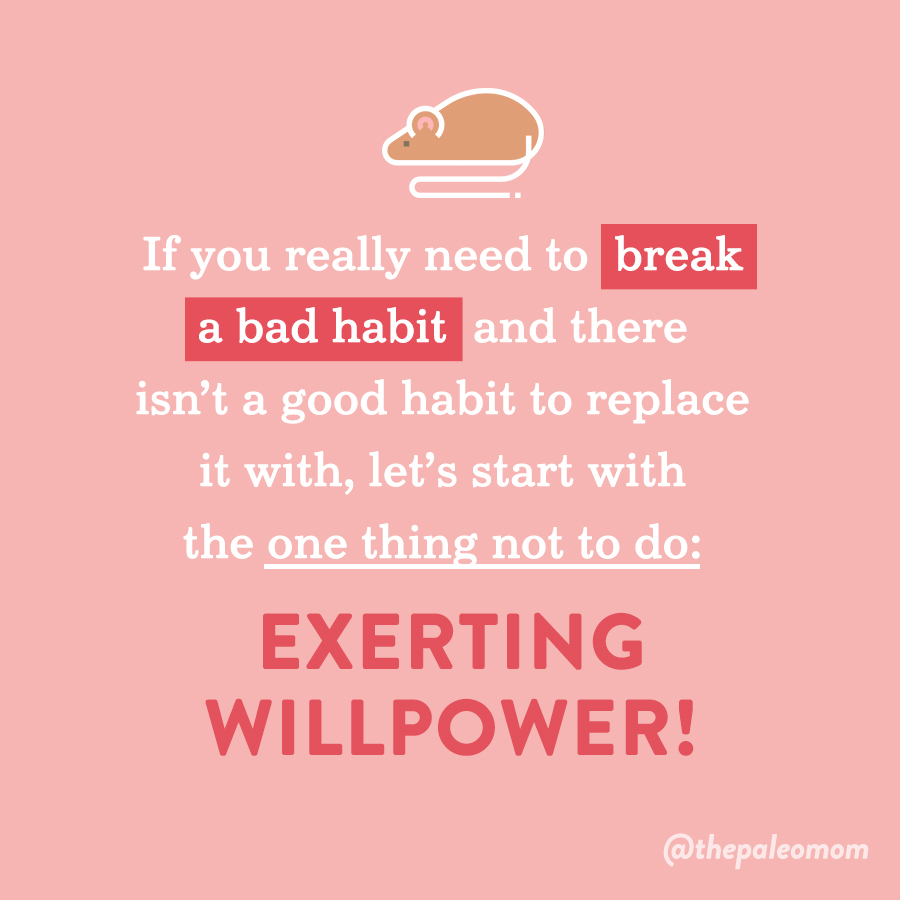
In contrast to habit formation, breaking a bad habit means that you cease doing something, and it’s not replaced with a new action (e.g., quitting snacking means that eating between meals isn’t replaced with any particular behavior). It is definitely tougher to break a bad habit compared to forming a new habit (as Yoda says “you must unlearn what you have learned”, easier said than done!). So, as you ponder your goals for 2021, first think creatively in terms of habit formation. Is there any way you can translate your goal to forming a good habit or replacing a bad habit with a good habit?
If you really need to break a bad habit and there isn’t a good habit to replace it with, let’s start with the one thing not to do: exerting willpower!
Studies that have looked at behavior repression (using willpower or self-control to not do something) show that it causes a rebound effect. For example, one study found that people who suppressed their thoughts about eating chocolate ended up consuming significantly more chocolate than those who didn’t. A similar study found that smokers who tried to not to think about smoking ended up thinking about it and craving it even more.
So then, how do we break a bad habit? There are two science-backed options.
One option is to create some kind of interference with the behavior that forces the prefrontal cortex to kick in so you think about what you’re doing. For example, a study showed that if people are forced to eat popcorn with their non-dominant hand at the movies, they’re able to break the habit of snacking at the theatre. (This same study found that habitual popcorn eaters even ate stale popcorn [ew!] without thinking about it, more supporting evidence that reducing reward doesn’t break a bad habit.) Other studies have shown that if you can delay the behavior long enough for conscious thought to kick in, the brain to switch to a goal-directed behavior (or a goal-directed inaction).
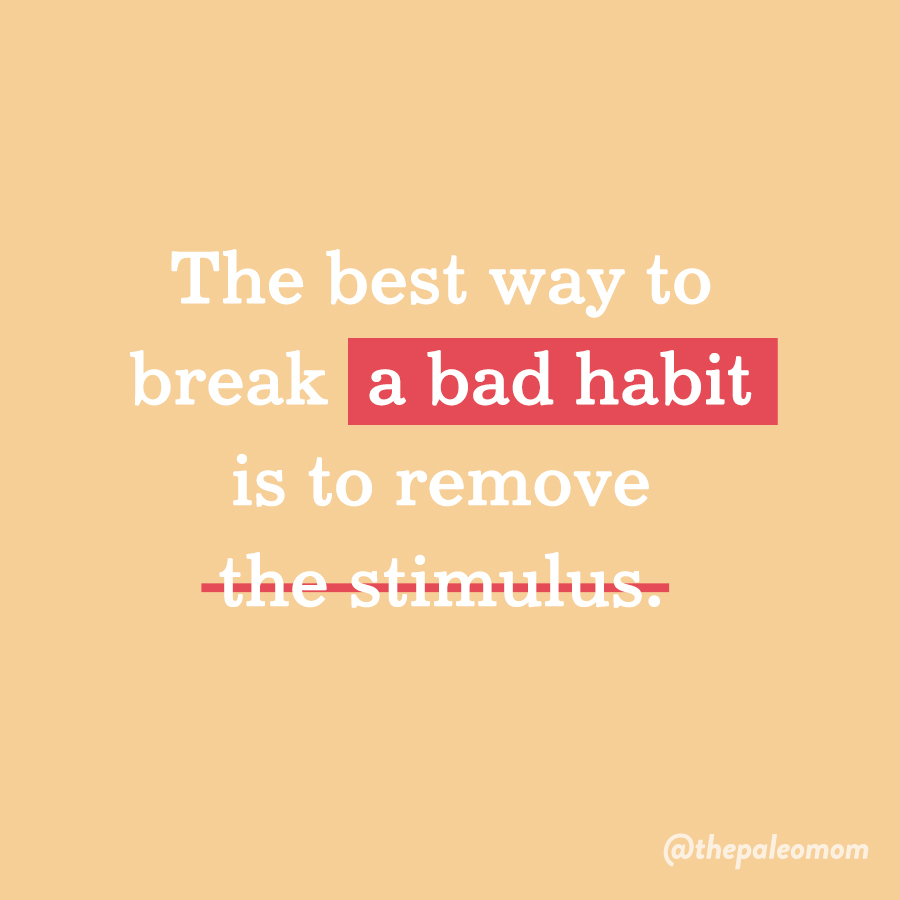 The best way to break a bad habit is to remove the stimulus. Studies have shown that removal of the cue or trigger for a habitual behavior is one of the most effective ways to break a bad habit. This is why so many people find it easier to quit smoking while on vacation and why wellness retreats can be such a great jump-start for a health journey. Similar studies have shown that changing the environment is important for treating substance abuse. You can apply the insights from this research by thinking through the habit you want to break and identifying the stimulus or stimuli. If it’s not possible to remove the stimulus entirely, think about how you can change or disrupt the stimulus enough that your prefrontal cortex has to kick in and you can switch to goal-directed behavior instead. This can be as simple as moving the snacks to a new cupboard.
The best way to break a bad habit is to remove the stimulus. Studies have shown that removal of the cue or trigger for a habitual behavior is one of the most effective ways to break a bad habit. This is why so many people find it easier to quit smoking while on vacation and why wellness retreats can be such a great jump-start for a health journey. Similar studies have shown that changing the environment is important for treating substance abuse. You can apply the insights from this research by thinking through the habit you want to break and identifying the stimulus or stimuli. If it’s not possible to remove the stimulus entirely, think about how you can change or disrupt the stimulus enough that your prefrontal cortex has to kick in and you can switch to goal-directed behavior instead. This can be as simple as moving the snacks to a new cupboard.
Also be aware of unintentional removal of a good habit stimulus. For example, a study showed that a break from school or work for the holidays can disrupt the healthy habit of going to the gym. This is why it’s so easy to derail from our healthy lifestyle over the holidays (and so much work to get back on track in January!).
One last strategy that is worth mentioning: mindfulness. In one study, mindfulness practice reduced craving-related eating by over 40%. In another study, mindfulness practice increased success of quitting smoking by a whopping 5 times over the American Lung Association’s Freedom From Smoking (FFS) treatment! Learn more about mindfulness in How Stress Undermines Health.
Let the Good Habits Take Over
When we are distracted, stress, anxious, or tired, we fall back on habits, whether good or bad. This is both why bad habits can undermine our ability to progress towards a goal and why good habits can keep us on track—without the need for willpower or self-control—even when life gets overwhelming. So, instead of fighting a powerful form of learning, think about the good habits you can form to ditch the on-again-off-again cycle for good.
To promote habit formation:
- identify the new behavior you intend to turn into a habit and the specific context you wish to trigger your new habit
- develop a positive attitude about your new behavior through education and/or identification of reward or positive outcomes
- translate that intention into action with sustained repetition of your behavior when you encounter the stimulus within a routine
It’s always easier to replace a bad habit with a good habit, but in the absence of a suitable good habit replacement, identify and remove the bad habit triggers. Maybe this means rearranging your desk to stop a grazing habit at work, or driving a different route home to avoid the drive-thru.
And note that habits can be created iteratively. If your goal is to increase your vegetable intake to 8 servings per day, your first action may be to add a serving of veggies to your lunch every day. After that becomes habit, your new action may be to add a serving of veggies at breakfast. After that becomes habit, add a serving of veggies at dinner. Keep going, small step by small step, until you reach your desired vegetable intake. It can be much easier to make lasting positive change when large and complex goals are broken up into smaller and more easily attainable habits.
Focusing on habit formation also requires frequent reevaluations. Sometimes our efforts to form a habit can wane without us intending to do so. This is why I don’t limit myself to resolutions once a year, but make them any time a little extra resolve is needed.
Citations
Ashby FG, Turner BO, Horvitz JC. Cortical and basal ganglia contributions to habit learning and automaticity. Trends Cogn Sci. 2010 May;14(5):208-15. doi: 10.1016/j.tics.2010.02.001.
Bargh JA, Morsella E. The Unconscious Mind. Perspect Psychol Sci. 2008 Jan;3(1):73-9. doi: 10.1111/j.1745-6916.2008.00064.x.
Courter RJ, Ahmed AA. To break a habit, timing’s everything. Nat Hum Behav. 2019 Dec;3(12):1244-1245. doi: 10.1038/s41562-019-0744-x.
Ersche KD, Lim TV, Ward LHE, Robbins TW, Stochl J. Creature of Habit: A self-report measure of habitual routines and automatic tendencies in everyday life. Pers Individ Dif. 2017 Oct 1;116:73-85. doi: 10.1016/j.paid.2017.04.024.
Erskine JA, Georgiou GJ, Kvavilashvili L. I suppress, therefore I smoke: effects of thought suppression on smoking behavior. Psychol Sci. 2010 Sep;21(9):1225-30. doi: 10.1177/0956797610378687.
Erskine JA. Resistance can be futile: investigating behavioural rebound. Appetite. 2008 Mar-May;50(2-3):415-21. doi: 10.1016/j.appet.2007.09.006. Epub 2007 Sep 29.
Eryilmaz H, Rodriguez-Thompson A, Tanner AS, Giegold M, Huntington FC, Roffman JL. Neural determinants of human goal-directed vs. habitual action control and their relation to trait motivation. Sci Rep. 2017 Jul 20;7(1):6002. doi: 10.1038/s41598-017-06284-y.
Fredslund EK, Leppin A. Can the Easter break induce a long-term break of exercise routines? An analysis of Danish gym data using a regression discontinuity design. BMJ Open. 2019 Feb 13;9(2):e024043. doi: 10.1136/bmjopen-2018-024043.
Galla BM, Duckworth AL. More than resisting temptation: Beneficial habits mediate the relationship between self-control and positive life outcomes. J Pers Soc Psychol. 2015 Sep;109(3):508-25. doi: 10.1037/pspp0000026.
Gardner B, Lally P, Wardle J. Making health habitual: the psychology of ‘habit-formation’ and general practice. Br J Gen Pract. 2012 Dec;62(605):664-6. doi: 10.3399/bjgp12X659466.
Gremel CM, Chancey JH, Atwood BK, Luo G, Neve R, Ramakrishnan C, Deisseroth K, Lovinger DM, Costa RM. Endocannabinoid Modulation of Orbitostriatal Circuits Gates Habit Formation. Neuron. 2016 Jun 15;90(6):1312-1324. doi: 10.1016/j.neuron.2016.04.043.
Judah G, Gardner B, Aunger R. Forming a flossing habit: an exploratory study of the psychological determinants of habit formation. Br J Health Psychol. 2013 May;18(2):338-53. doi: 10.1111/j.2044-8287.2012.02086.x.
Judah G, Gardner B, Kenward MG, DeStavola B, Aunger R. Exploratory study of the impact of perceived reward on habit formation. BMC Psychol. 2018 Dec 20;6(1):62. doi: 10.1186/s40359-018-0270-z.
Karppinen P, Oinas-Kukkonen H, Alahäivälä T, Jokelainen T, Teeriniemi AM, Salonurmi T, Savolainen MJ. Opportunities and challenges of behavior change support systems for enhancing habit formation: A qualitative study. J Biomed Inform. 2018 Aug;84:82-92. doi: 10.1016/j.jbi.2018.06.012.
Knowlton BJ, Patterson TK. Habit Formation and the Striatum. Curr Top Behav Neurosci. 2018;37:275-295. doi: 10.1007/7854_2016_451.
Lally, P., van Jaarsveld, C. H. M., Potts, H. W. W., & Wardle, J. How are habits formed: Modelling habit formation in the real world Eur. J. Soc. Psychol. 2010;40(6):998-1009. https://doi.org/10.1002/ejsp.674
Luque D, Molinero S, Watson P, López FJ, Le Pelley ME. Measuring habit formation through goal-directed response switching. J Exp Psychol Gen. 2020 Aug;149(8):1449-1459. doi: 10.1037/xge0000722.
Mason AE, Jhaveri K, Cohn M, Brewer JA. Testing a mobile mindful eating intervention targeting craving-related eating: feasibility and proof of concept. J Behav Med. 2018 Apr;41(2):160-173. doi: 10.1007/s10865-017-9884-5.
Mendelsohn AI. Biol Psychiatry. Creatures of Habit: The Neuroscience of Habit and Purposeful Behavior. 2019 Jun 1;85(11):e49-e51. doi: 10.1016/j.biopsych.2019.03.978.
Neal DT, Wood W, Quinn JM. Habits—A repeat performance. Curr. Dir. Psychol. Sci. 2006, 15, 198–202.
Oikonomou MT, Arvanitis M, Sokolove RL. Mindfulness training for smoking cessation: A meta-analysis of randomized-controlled trials. J Health Psychol. 2017 Dec;22(14):1841-1850. doi: 10.1177/1359105316637667.
Smith KS, Graybiel AM. Habit formation. Dialogues Clin Neurosci. 2016 Mar;18(1):33-43. doi: 10.31887/DCNS.2016.18.1/ksmith.
Tudor-Locke C, Bassett DR Jr. How many steps/day are enough? Preliminary pedometer indices for public health. Sports Med. 2004;34(1):1-8. doi: 10.2165/00007256-200434010-00001.
Urcelay GP, Jonkman S. Delayed rewards facilitate habit formation. J Exp Psychol Anim Learn Cogn. 2019 Oct;45(4):413-421. doi: 10.1037/xan0000221. Epub 2019 Aug 1. PMID: 31368767
Vandaele Y, Janak PH. Defining the place of habit in substance use disorders. Prog Neuropsychopharmacol Biol Psychiatry. 2018 Dec 20;87(Pt A):22-32. doi: 10.1016/j.pnpbp.2017.06.029.
Wood W, Rünger D. Psychology of Habit. Annu Rev Psychol. 2016;67:289-314. doi: 10.1146/annurev-psych-122414-033417.
Wood W, Tam L, Witt MG. Changing circumstances, disrupting habits. J Pers Soc Psychol. 2005 Jun;88(6):918-933. doi: 10.1037/0022-3514.88.6.918.
Yin HH, Knowlton BJ. The role of the basal ganglia in habit formation. Nat Rev Neurosci. 2006 Jun;7(6):464-76. doi: 10.1038/nrn1919.









